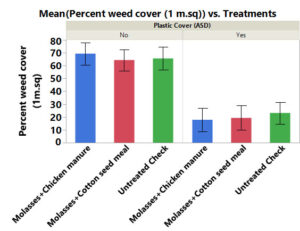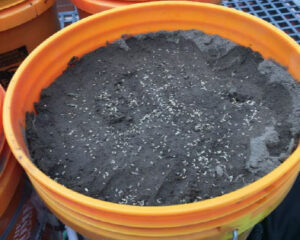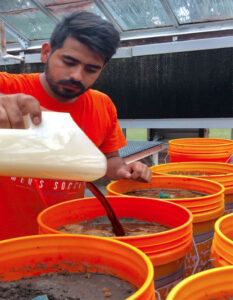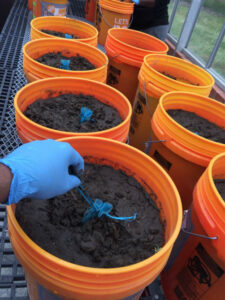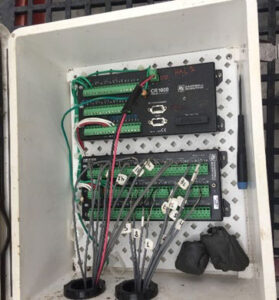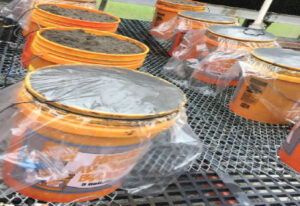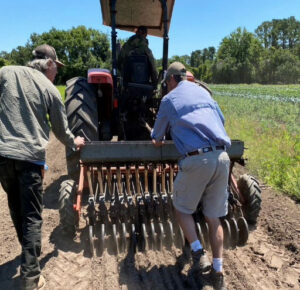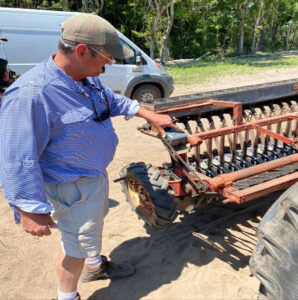Final report for LS19-306
Project Information
A significant number of farmers are switching from conventional to organic production due to large consumer demands and high market cost of produce. Organic sales hit $55.1 billion in 2019 as the importance of organic continues to rise. Organic vegetable and fruit sales increase by 5 percent, hitting $18 billion, as the category continues to be the star of the organic sector, and often the starting point for organic food buying.
Weeds and pathogens, however, are challengers in sustainable production, specifically in organic vegetable production. Most of the organic growers rely on hand weeding, which can be labor intensive and costly. Weed density and biomass were found to be four times higher in the organic systems than in the conventional systems and under standard weed management practices, organic had 40 percent lower yield than the conventional system (Benaragama et al., 2016). Certain varieties of vegetables have been bred for resistance to key pathogens and insects, yet no type of inherent resistance mechanisms exists in crops that will directly resist weed infestation. Additionally, no selective herbicides are registered for use in organic vegetable production. There is a great need to develop alternatives for sustainable vegetable management.
Anaerobic soil disinfestation, a pre-plant biological soil treatment, has been shown to suppress certain weed species and soil-borne pathogens. Furthermore, preliminary data taken from the USDA-ARS United States Vegetable Laboratory in Charleston, S.C., by Dr. Cutulle and Dr. Wechter indicate that carbon source influences weed suppression. First developed in Japan and the Netherlands (Blok et al., 2000), ASD works by driving the soil into an anaerobic state for several weeks, thus reducing or eliminating the aerobic microorganisms. Most plant pathogenic microorganisms are aerobic. ASD is facilitated by amending the soil with a high carbon source, followed by sealing the soil in an impermeable plastic mulch and driving the soil into an anaerobic state by saturating the soil under the mulch with water. We propose evaluating several carbon sources that have allelopathic properties, and incorporate them into an ASD program. Additionally, a new liquid formulation of corn gluten meal has been developed in the past year. Proteins in corn gluten meal inhibit the germination of grasses and small seeded broadleaf weeds. We will test this product as both an ASD carbon source, as well as its effect on weed suppression. ASD has been shown to be an effective method for reducing or eliminating several soilborne phytopathogens. Dr. Wechter is currently working on the remediation of the devastating soil pathogen Ralstonia solanacearum that causes bacterial wilt of tomato and pepper. This pathogen is the most crop limiting pathogen of tomato in southern U.S. Preliminary work by Dr. Wechter has indicated that ASD is capable of greatly reducing and even eliminating the R. solanacearum in the field. Also, we will evaluate summer cover crops as carbon sources as an ASD scenario. This technique has also shown the potential to control nutsedge (Butler et al., 2012), but there is no study conducted in detail optimizing ASD as a multiple weed control technique.
- To determine the best allelopathic-organic herbicide amendment for control of annual grasses, broadleaf weeds, and sedge control in an ASD environment. Specifically the allelopathic material treatments will include mustard meal, sweet potato skins, dry corn gluten meal, liquid corn gluten meal, and no amendment.
- To determine if specific carbon source and allelopathic treatment combinations affect weed suppression and disease incidence in native coastal soil in the greenhouse. Specifically we will evaluate two carbon sources: Rice Bran and chicken manure plus molasses, with the best allelopathic amendments from Objective 1 in an ASD promoted environment.
- To evaluate the best options from the greenhouse trials and evaluate them in a field trial in the fall of year 1 and year 2 in pepper, tomato and eggplant.
- To determine the best summer cover crop residue for use as a carbon source in an ASD scenario in the field. Three cover crops will be evaluated: soybean, sunn hemp, and sorghum sudan grass.
- To determine if the best options compare to standard practices in commercial tomato and pepper farm settings in coastal South Carolina.
Cooperators
- - Producer
- - Producer
- - Producer
- - Producer
Research
A. ASD for Pathogen Control and Weed Suppression
The following progress report follows the work conducted by graduate student Gursewak Singh on the project.
How Anaerobic Soil Disinfestation (ASD) Works:
- Incorporate organic material (Provides C source to microbes).
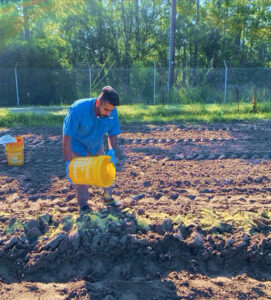
- Irrigate to saturation (Water-filled pore spaces).
- Cover with plastic mulch (Creates anaerobic conditions and stimulate decomposition of organic material).
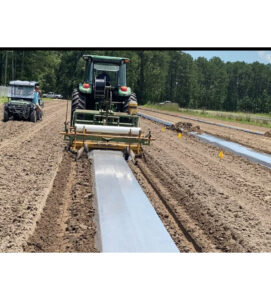
Preliminary Experiment (July-September 2019)
Location: USDA ARS Vegetable Research, Charleston, S.C.
Carbon treatments (Figure 1):
- Molasses and chicken manure
- Molasses and cottonseed meal
- No carbon source
Experiment unit was a field plot with 40 ft. X 1.5 ft. dimensions.
Experimental design was a randomized complete block split plot (plastic cover and no plastic cover) with 6 replications.
Figure 1: Mean (Percent Weed Cover, 1 m.sq, ) vs. Treatments
ASD Carbon Sources Study (October-December 2019)
Objective: To determine if the carbon source and allelopathic-organic herbicide treatment combinations affect weed suppression and pathogen (specifically Ralstonia solanacearum) in an ASD environment in the greenhouse.
Treatments:
- Mustard meal + molasses
- Chicken manure + molasses
- Sweet potatoes + molasses
- Corn gluten + molasses
- No carbon source
Five treatments mixtures with or without plastic mulch, in 10 total treatments. Experiment unit was a 5-gallon bucket. Experimental design was a completely randomized block design with four replicates of each treatment. Kept for six weeks in the greenhouse. After six weeks, the plastic cover was removed. Data collection included total weed population, percent weed cover and each weed counts. Ralstonia solanacearum inoculate soil mesh bags were sampled in plant pathology laboratory.
Palmer amaranth, Echinochloa crusgalli and Digitiria sp. seeded
Incorporation of carbon sources
Ralstonia solanacearum inoculated soil buried at 20-25 cm depth and then topped off with soil
Oxidation reduction electrodes were installed to evaluate soil anaerobic conditions
Plots covered with transparent plastic sheet
B. ASD Cover Crops Incorporated Field Study (ongoing)
Objective: To determine if the incorporation of cover crops affect weed suppression and disease incidence in an ASD environment in organic tomato production.
Treatments:
- sunhemp
- sorghum sudangrass
- mix (sunhemp and sorghum sudangrass)
- no cover crop
Four treatments with and without plastic mulch, for 8 total treatments.
The experiment was conducted at the CREC organic farming unit and experimental unit is 20 ft. long and 4 ft. weed. Experimental design is completely randomized block design with four replicates of each treatment.
Cover crops sowing began April 28. The cover crops will be terminated 45-50 days, depending on weather conditions and incorporation into the soil. ASD will be practiced for 4 weeks by covering assigned plots with plastic mulch and ORP probes to monitor the anaerobic conditions in the soil. Tomato plants will be transplanted after 4 weeks. Data collection includes tomato yields, weed control ratings, and disease ratings.
Description of Adair McKoy and Pete Ambrose Trial that occurred on Wadmalaw Island and Harleston Towles trial on Edisto island are listed below. Includes methods and results.
Harleston Towles Field Trial on Edisto island is described in the media link below.
Results and methods of the cover crop ASD study cconducted at the research center in Charleston are listed in the link below.
Results of the Carbon Source Field Study are listed below in the media link.
Graphs and Tables_Cover Crop_ASD
Methods and Results from the IRIS tube study (Validates the use of IRIS tubes in future on farm studies) is pasted below.
Presentations in the methods section include results as well
SouthernSARE_Publication Carbon Source
SouthernSARE_Covercrop_publication
Education
Graduate Student Gursewak Singh's MS was funded through this grant. He won an award at the Weed Science Society of America in 2021 for his work on this project.
Educational & Outreach Activities
Participation Summary:
Extension work included grower farm visits and on-farm trials.
- Visited Titan farms, largest peach grower on the East Coast. They also grow pepper and broccoli on 2000 acres.
- Hosted cover crop trials under the guidance of Dr. Brian Ward at two South Carolina cooperative organic growers: Harleston Towles and Sidi Limehouse. Rosebank farms (a successful vegetable grower) grows more than 50 horticultural crops annually.
- Hosted ASD carbon sources trials at two grower farms: Adair Mccoy and Pete Ambrose.
Dr. Brian Ward guiding cover crop seeding and farmers field design.
Networking opportunities included:
- Attending the joint North and South Carolina Vegetable Growers Meeting in 2019 in Wilmington, N.C.
- Attending the annual Soil Health Conference in 2019 at Clemson University.
- Presenting the ASD studies results orally at the Southern Weed Science Society Meeting, January 2020 in Biloxi, MS.
- Registered to present orally at the upcoming national ASHS, August 2020 in Orlando, FL.
Learning Outcomes
Project Outcomes
This was the first funded project in South Carolina that research and extension on Anaerobic Soil Disinfestation. The results of this study have been presented at multiple field days and some growers have claimed they have adopted some form of ASD. Currently we are working to optimize local carbon waste streams in a USDA-OREI grant. We are also working with a half dozen other farms on other ASD funded projects. The funding from this grant was pivotal for understanding the fit that ASD has in SC vegetable production as well as dissemination of the information to SC growers.
